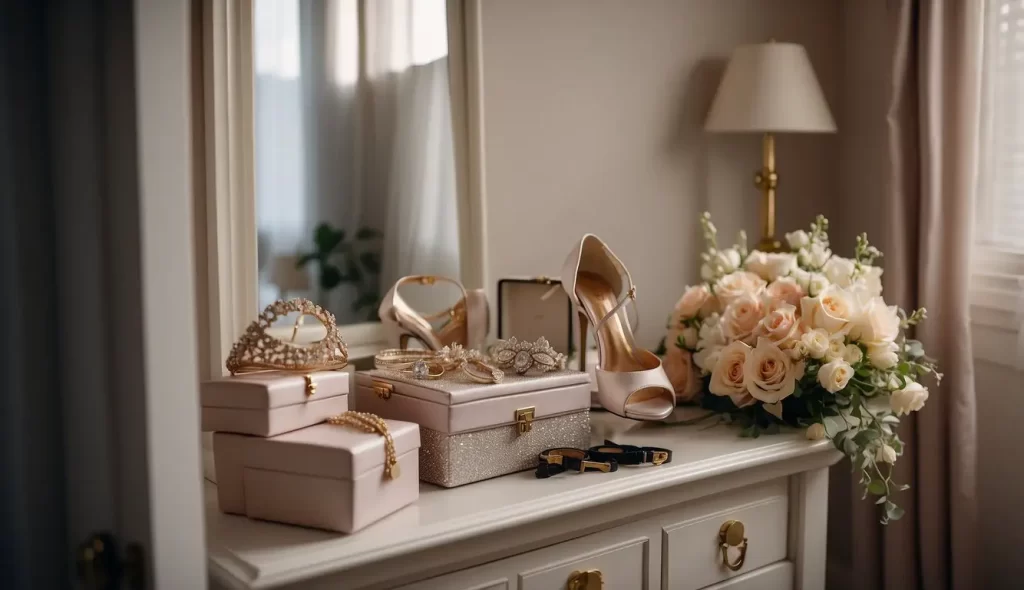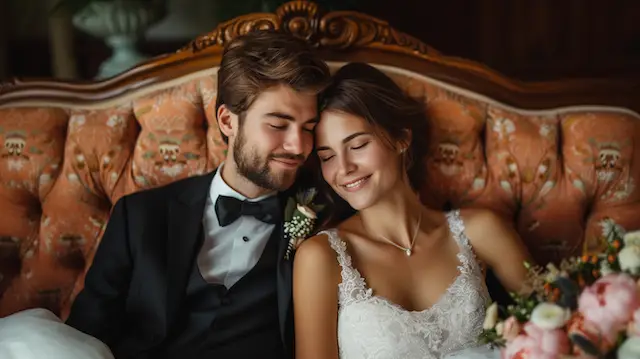How Long Do Weddings Last: A Timely Breakdown for Couples
On average, traditional weddings in the US usually last between four to six hours in terms of the actual celebration.
For example, a six-hour wedding would include about one hour for invitation and ceremony, a one-hour cocktail reception, and four hours of dinner and dance.
Certainly, weddings can vary in length, depending on cultural and personal preferences.
The duration of the actual ceremony, the number of guests and the logistics behind it, and the time taken for photography, entertainment, and dining are just a few variables at play.
Additionally, the order in which these events occur will further shape your wedding day timeline.
To effectively plan your wedding day, you want to ensure you understand the time commitments for each segment of the festivities.
With this knowledge, you can keep control of your wedding timeline while reflecting on your unique vision and ensuring a seamless flow of events, freeing you to enjoy your special day.
Pre-Wedding Preparations

Pre-wedding preparations are essential to any wedding and usually take a significant amount of time. They can almost double the time you will need for your entire wedding on the day of the event if you want to look at it this way.
To ensure everything runs smoothly, allocate sufficient time for each activity and segment, such as hair and makeup, bridal party, and family portraits. Proper planning and following a timeline is crucial to avoid delays and unwanted stress on your special day.
Hair and Makeup
Allocating ample time for hair and makeup is vital to achieving your desired look. It typically takes 1-2 hours for brides and 45-60 minutes for bridesmaids and family members.
Here’s a sample schedule to help you plan:
| Person | Duration |
|---|---|
| Bride | 1.5 – 2 hours |
| Bridesmaids | 45 – 60 minutes |
| Family members | 30 – 45 minutes |
Consider having a trial run with your hairstylist and makeup artist to streamline the process. This will allow you to finalize your style preferences and ensure no surprises and delays on your wedding day.
Bridal Party and Family Portraits
Portrait and detail shots are like a treasure chest of memories with your loved ones. To have a smooth and effective photo session, stick to these guidelines:
- Prepare a list: Create a list of all the groupings you want to be captured. Don’t forget to include grandparents, siblings, and close friends.
- Timing: Allocate approximately 30-45 minutes for bridal party photos and 30-45 minutes for family portraits.
- How Long Do Weddings Last: A Timely Breakdown for Couples: Choose a location that is easily accessible to all members, and consider the lighting and background.

Ceremony Details
Ceremony Start Time
Traditionally, ceremonies occur in the afternoon, between 3:00 and 5:00 pm.
However, depending on the season, location, and personal preferences, you might choose a different time.
Allow room for contingencies, such as traffic delays and time flexibility for late-arriving guests.
Type of Ceremony
There are generally two main types of ceremonies: religious and non-religious. The type of ceremony will significantly impact the ceremony length and the time allocated for the reception. Here’s a quick overview of both types:
- Religious ceremonies: These usually follow a formal structure determined by the specific religion or denomination. They may include prayers, readings, and rituals. Expect religious ceremonies to last anywhere from 45 minutes to 2 hours.
- Non-religious ceremonies: Also referred to as secular or civil ceremonies, these are less structured and can be customized to your preferences. Non-religious ceremonies typically last 30 minutes to an hour.
| Ceremony Type | Duration |
|---|---|
| Religious | 45min – 2hrs |
| Non-religious | ~ 30min |
Ceremony length varies based on several factors, including the type of ceremony, selected rituals, and your preferences. As mentioned earlier, religious ceremonies often take longer than non-religious ones.
For most weddings, the ceremony lasts between 30 minutes to an hour max, allowing time for the officiant’s speech, vows exchange, ring exchange, and other rituals (unity candle, sand ceremony, etc.). Ensure that you communicate with your officiant about the desired duration, and they can tailor the ceremony to fit your timeline.

Post-Ceremony Events
Cocktail Hour
After your wedding ceremony, it’s time for the cocktail hour. Usually lasting around 60 minutes, the cocktail hour allows guests to mingle, enjoy refreshments, and relax while you and your partner participate in a photo session. To make the most of this time, you can:
- Offer a variety of beverages, both alcoholic and non-alcoholic
- Provide hors d’oeuvres and food stations
- Set up comfortable seating areas for relaxation
- Arrange for soft background music
Remember to inform your guests about the event’s schedule on your invitations so they know what to expect during the wedding reception.
Check out the keys to a memorable day in our [what makes a wedding successful] article, where we uncover the elements that make celebrations shine.”
Grand Entrance
When the cocktail hour ends, it’s time to transition to dinner and dance with your grand entrance into the ballroom alongside your partner and wedding party.
Here are a few tips to make your grand entrance unforgettable:
- Select an upbeat, meaningful song to set the tone
- Coordinate a unique entrance (such as a choreographed dance)
- Introduce the wedding party in pairs or individually
- Allow time for applause and cheers from your guests
Once everyone has gathered and welcomed the bridal party, it’s time to hit the dance floor and celebrate. Guests can enjoy a night of dancing, dining, and creating memories with their friends and family.
The wedding reception usually unfolds over a few hours, accommodating speeches, toasts, and other traditions.
As each post-ceremony event occurs, remember that the schedule is flexible and can be tailored to fit your preferences, but make sure you check with your venue and vendors on costs overtime, in case you need to extend the duration.
Reception Run-Down
Dinner and Speeches
After the ceremony and cocktail reception, your wedding dinner & dance take center stage.
A well-organized timeline of your dinner plays a crucial role in determining how long this enjoyable part of the day lasts.
Dinner and speeches typically take up a significant portion of the reception, but you want to leave enough extra time for dancing.
For a sit-down dinner, allocate around 1.5 to 2 hours for everyone to eat comfortably. In the meantime, weave in the toast and speeches, which usually take approximately 30 minutes, plus time for dance sets.
Here’s a suggested breakdown:
- Toast (5 minutes): The best man or maid of honor proposes a toast to the couple as dinner commences.
- Speeches (20 minutes): Occurring during dinner, speeches are given by the wedding party and family members, often in this order: parents, best man/maid of honor, and then the newlyweds.
To help things run smoothly, encourage speakers to limit their speeches to 3-5 minutes each.
First Dance and Dance Floor Opening
A key event is the first dance, which usually lasts 3-4 minutes. Once you have enjoyed this special moment, the dance floor officially opens up to all guests.
Here’s a possible agenda for this part of the evening:
- Couple’s first dance (3-4 minutes): This is a special moment for the newlyweds to share their first dance.
- Parents’ dances (~ 10 minutes): The bride, her father, and then the groom and his mother take turns on the dance floor.
- General dancing (1-2 hours): The DJ or band invites all guests to join in the dancing, creating a convivial atmosphere.
Cake Cutting and Bouquet Toss
Build in extra time if you plan to do the cake cutting and bouquet toss.
- Cake cutting (5-10 minutes): The newlyweds cut the cake together, with everyone gathered to watch this symbolic moment.
- Bouquet toss (5 minutes): The bride tosses her bouquet to the single ladies in the crowd, followed, optionally, by the groom tossing the garter to the single men.
Wedding Reception Timeline
Typical Duration
A typical wedding reception lasts about 4 to 6 hours. Here’s a general guideline for structuring your timeline:
- Cocktail Hour (1 hour): Immediately following the ceremony, guests can mingle and enjoy appetizers and drinks.
- Dinner (1.5 to 2 hours): Depending on your chosen dining style, such as a buffet or plated service, this portion of the evening may vary in length.
- Toasts and Speeches (30 minutes): Allocate time for the best man, maid of honor, and anyone who wishes to deliver a toast.
- First Dance and Parent Dances (15 minutes): The newlyweds will share their first dance, followed by the parent dances.
- Party Time (2 – 3 hours): With formalities complete, guests can dance, drink, and celebrate the newlyweds.
- Cake Cutting and Bouquet Toss (15 minutes): Incorporate these traditional activities towards the end of the evening.
Remember that the timing may shift based on your preferences and schedule.
Variations by Culture and Preference
Wedding receptions can vary greatly depending on cultural traditions and personal preferences. Here are a few examples of how the timeline may differ:
- Indian weddings: Often lasting for multiple days, the wedding event concludes with a reception lasting up to 4 hours. The reception usually includes dinner, music, and dancing.
- Hispanic weddings: The reception traditionally begins with a grand entrance, followed by a first dance, food, and dancing. Mariachi bands or Latin music may provide entertainment. The event might last 6 hours or longer.
Closing the Celebration
Last Dance
As the evening goes on, you’ll inevitably begin to wind down your wedding celebrations. A popular tradition is to plan for a last dance.
Usually around 5 to 10 minutes before the set ending time, the last dance signifies that the end of the evening wedding is near.
Selecting a meaningful song for this moment creates a memorable emotional connection with your wedding guests. Some couples choose a slow, romantic song, while others prefer a high-energy tune to get their guests pumped for the next part of the event, which could be an afterparty at another venue.

Grand Exit
A carefully planned exit is a fun Hollywood movie-like way to end your wedding reception and leave a lasting impression on your guests.
Often orchestrated with a coordinated send-off, the grand exit can take various forms. Here are a few ideas to help you plan it:
- Sparkler Send-Off: A popular option is to have guests line up, and light sparklers as you and your spouse make your way happily through the illuminated corridor.
- Bubble Send-Off: Another option is to provide wedding guests with small bottles of bubbles as they blow countless shimmering orbs around you on your way out.
- Confetti or Flower Petals: An eco-friendly alternative, showering the newlyweds with biodegradable confetti or flower petals offers a delicate and visually stunning farewell.
Regardless of your choice, ensure your grand exit is well-timed (shortly after the last dance), adequately supervised, and follows the venue’s guidelines to wrap up your evening wedding on a high note.
Planning and Coordination
Working with Wedding Planners
Hiring a wedding planner will help you stick to a timeline so that you can freely enjoy your special day without worrying about any details that could affect the length of your wedding. These experts offer guidance throughout the planning process and coordinate the event on the big day.
Working with a wedding coordinator ensures all details are taken care of, allowing you and your guests to enjoy the celebration fully.
Creating a Wedding Itinerary
To help keep your wedding on track and within your desired timeframe, follow these steps:
- List the major events: Identify the key moments you want to include in your wedding, such as the ceremony, cocktail hour, and reception.
- Allocate time for each event: Estimate how long each moment should last. This will help you create a timeline that helps regulate the flow of your wedding.
- Factor in extra time: Add time for transitions and unforeseen circumstances, especially if the ceremony and reception are at different locations.
- Share the itinerary: Ensure your vendors, wedding planner, and bridal party know the schedule.
Here’s a sample wedding timeline:
| Time | Event |
|---|---|
| 4:00 pm | Invitation (~ 30 min.) & Ceremony (~ 30 min.) |
| 5:00 pm | Cocktail hour |
| 6:00 pm | Guests are ushered into ballroom |
| 6:15 pm | Newlywed’s Grand Entrance |
| 6:18 pm | First Dance (B&G), then bridal party and guests join the dance floor |
| clear dance floor | |
| 6:30 pm | Dinner: First Course served |
| 6:45 pm | Speech(es) Best Man, Maid of Honor |
| 7:00 pm | Dance set |
| clear dance floor | |
| 7:15 pm | Dinner: Entrees served |
| 7:45 pm | Parent dances |
| 7:55 pm | into dance set |
| clear dance floor | |
| 8:10 pm | Cake-cutting |
| 8:15 pm | Re-open dance floor |
| 8:20 pm | Dessert served |
| 9:50 pm | Last Dance |
| 10:00 pm | Conclusion, – send-off |
Remember that every wedding is unique, and your itinerary will likely differ from the example above. Collaborate with your wedding planner to ensure all your desired events are well-coordinated to create the memorable celebration you envision.

Frequently Asked Questions
What is the typical length of a wedding reception?
From start to finish, a typical wedding reception lasts around 4-6 hours, but it can vary depending on your preference, venue, and cultural or religious traditions. A typical 6-hour event would consist of a one-hour ceremony, followed by a one-hour cocktail reception, and concludes with four hours of dinner and dancing.
What does a typical wedding timeline look like?
A typical wedding timeline includes the ceremony, cocktail hour, first dance, dinner & dance, speeches, and other activities selected by the couple.
How should I start planning the wedding reception timeline?
Start planning your timeline based on the ceremony start time, the venue’s availability, and the desired end time, taking into account the various elements of the reception.
What is the most important part of the reception timeline?
The most important is ensuring enough time for each planned activity, from dinner and toasts to dancing and cake cutting, and sticking to it.
Should the wedding reception timeline align with the wedding vendors’ schedules?
Yes, this is essential. Share and coordinate the timeline with the schedules of wedding vendors, such as the caterer, photographer, and entertainer, to ensure a smoothly executed event.
How late can a wedding reception run until?
This usually depends on your venue’s policies and noise ordinances. In general, most wedding receptions end between 10 pm to midnight. However, some venues may allow you to extend your event for an additional fee. It’s always best to confirm with your venue beforehand to avoid potential issues on the wedding day. You also want to consider the comfort and convenience of all guests.
What part of wedding planning should the wedding reception timeline be a part of?
Your timeline is an integral part of wedding planning and should be carefully considered, as it directly impacts the flow and timing of the entire celebration.
You should start early in your journey, map out the most important events of the day, and create a realistic timeline that allows flexibility. Don’t forget to communicate this timeline with your wedding planner, bridal party, venue, and vendors to ensure everyone is on the same page.


